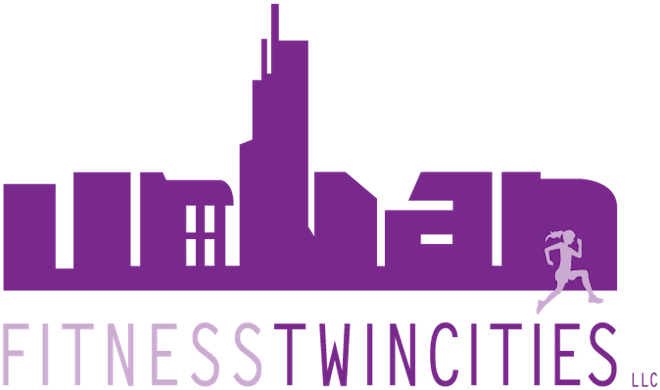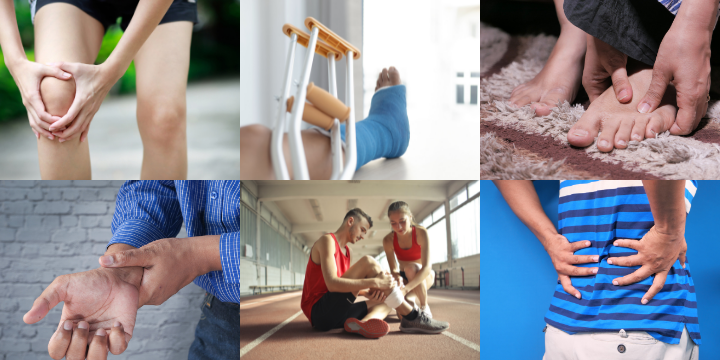Injury prevention is a necessary part of any functional workout!
 Injury prevention is important because, at best, injuries are no fun. They disrupt our lives and leave us in miserable pain; and one injury often leads to more injuries. Besides the physical pain, injuries can increase or cause depression or other mental health issues. Therefore, trying to prevent them is good for all aspects of our lives.
Injury prevention is important because, at best, injuries are no fun. They disrupt our lives and leave us in miserable pain; and one injury often leads to more injuries. Besides the physical pain, injuries can increase or cause depression or other mental health issues. Therefore, trying to prevent them is good for all aspects of our lives.
True injury prevention is made up of a number of different aspects, discussed in more depth below:
- Body Balance. A balanced body is comprised of balancing these different aspects:
- Strength
- Flexibility
- Mobility
- Alignment
- Balance Ability
- Body Awareness
- Stress Relief and Release
- Nutrition
Body Balance:
The most important part of injury prevention is creating balance throughout your body. Injuries can occur at any time for a variety of reasons. However, the more balanced your body is, the less likely you are to get injured, just as a well-maintained car is less likely to break down. When all the car parts are working well together, there is less strain on the engine and the car runs better. This helps prevent future problems. Our bodies are the same way. A balanced body is made up of four equally important aspects: strength, flexibility, mobility, and alignment.
Strength:
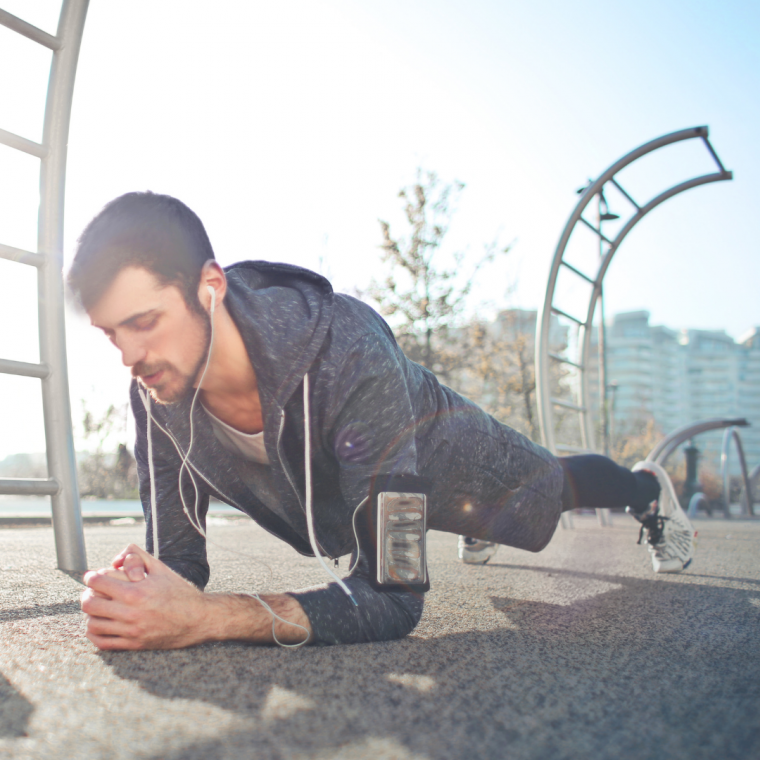 Strength isn’t just about being strong; it is about building equal strength in all your muscles on both sides of your body. When we do strength training, we often find that we naturally have one side stronger than another. This is because we generally have a dominant side and we have daily habits that encourage us to strengthen one side more than another in certain areas. For example, maybe we favor standing with our weight on one leg over the other instead of always standing on two legs equally; we may consistently pick up bags or books with the same hand or consistently carry children on one hip or purses on the one shoulder all the time. Even just doing things like always vacuuming holding the vacuum in one hand or constantly using our right arm on the computer mouse contributes to inequalities in our bodies. Did you ever notice which hand you are most likely to take off the wheel of the car? Mostly likely, it is the same hand time and time again, meaning you are controlling a heavy piece of machinery with the same one hand on a regular basis. Try taking your preferred hand off the wheel (on an empty street please!) and see if the car doesn’t suddenly feel a lot heavier or more difficult to control with the non-preferred hand.
Strength isn’t just about being strong; it is about building equal strength in all your muscles on both sides of your body. When we do strength training, we often find that we naturally have one side stronger than another. This is because we generally have a dominant side and we have daily habits that encourage us to strengthen one side more than another in certain areas. For example, maybe we favor standing with our weight on one leg over the other instead of always standing on two legs equally; we may consistently pick up bags or books with the same hand or consistently carry children on one hip or purses on the one shoulder all the time. Even just doing things like always vacuuming holding the vacuum in one hand or constantly using our right arm on the computer mouse contributes to inequalities in our bodies. Did you ever notice which hand you are most likely to take off the wheel of the car? Mostly likely, it is the same hand time and time again, meaning you are controlling a heavy piece of machinery with the same one hand on a regular basis. Try taking your preferred hand off the wheel (on an empty street please!) and see if the car doesn’t suddenly feel a lot heavier or more difficult to control with the non-preferred hand.
Just as we are constantly creating a strength imbalance in our daily lives, we can create imbalances in our strength training. Strength training is very important for injury prevention and our general health and well being. However, the imbalances in our daily lives creep into our strength training. Our stronger muscles are easier to engage because they are stronger. We often engage our stronger or more consistently engaged muscles over our weaker ones when simply doing exercises and don’t think about how we are doing an exercise. For example, have you ever had your neck hurt while trying to do a crunch, sit up, or Pilates’ hundreds? Or your low back hurt while trying to do a plank or push-ups? That is because these exercises should be using your core muscles. However, thanks to computers and hours of sitting, most of us tend to be weaker in our abs and stronger (or tighter) in our neck and shoulders and low back muscles. Therefore, the tighter and stronger muscles kick in to do the work because you told your body what movement to do instead of how to do it. This creates a continued imbalance of strengthening the stronger muscles, not just the weaker. Learn more about strength training and how to do get the most out of it.
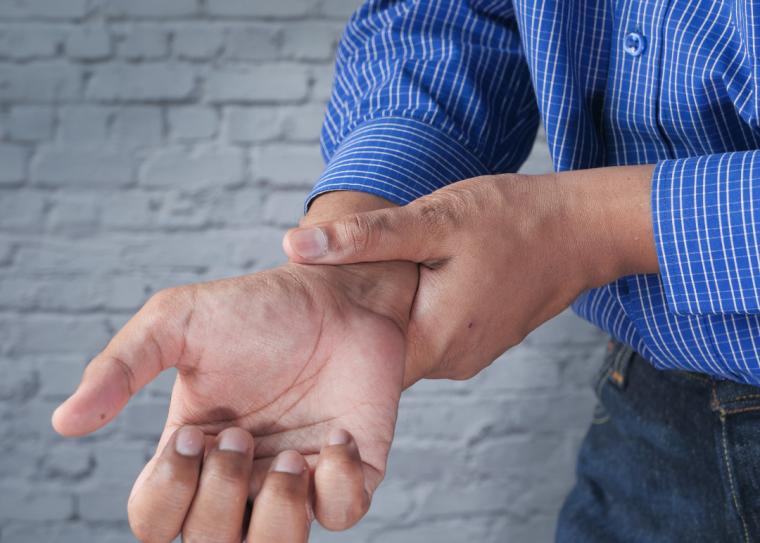 How does all this muscle imbalance increase your risk of injury? Well, when one muscle is overly strong and one is overly weak, this can cause any number of injuries. Overly strong muscles can become overly tight and over used. Then they can strain, sprain or tear. In addition, these overly strong muscles can give out when fatigued. If the muscles that support that fatigued muscle are too weak, they might give out too, causing things to roll or twist. An excellent example of this was a client who was twisted to the right in her hip and spine. Because of this twist, her right glute was weak and didn’t want to activate. Her ankle then became tired due to overuse because it was not getting the support it needed from the right glute. In the end, she sprained her right ankle doing a simple task because the ankle could not do any more and eventually gave out because glute couldn’t provide any support. This injury could have been prevented if her glute had been strong enough to support her ankle.
How does all this muscle imbalance increase your risk of injury? Well, when one muscle is overly strong and one is overly weak, this can cause any number of injuries. Overly strong muscles can become overly tight and over used. Then they can strain, sprain or tear. In addition, these overly strong muscles can give out when fatigued. If the muscles that support that fatigued muscle are too weak, they might give out too, causing things to roll or twist. An excellent example of this was a client who was twisted to the right in her hip and spine. Because of this twist, her right glute was weak and didn’t want to activate. Her ankle then became tired due to overuse because it was not getting the support it needed from the right glute. In the end, she sprained her right ankle doing a simple task because the ankle could not do any more and eventually gave out because glute couldn’t provide any support. This injury could have been prevented if her glute had been strong enough to support her ankle.
Also, when forced to work, the overly weak muscles can become injured from suddenly being asked to do too much or work for longer than they are capable of, causing them to tighten, strain, sprain or tear. For example, one of our clients injured his hamstring because his hamstrings were weak. When he purchased a new house and moved, he was suddenly painting and moving furniture for weeks on end. Therefore, he over used his hamstring that couldn’t keep up with the pace he was having to put it through.
In addition, the imbalance of the tight and loose muscles can cause joints to twist or bones to be pulled out of place. This is especially true for hypermobile, or double jointed, people whose ligaments are loose and, therefore, don’t hold their bones in place. It is also true for pregnant women whose ligaments loosen during pregnancy, making it easier for a tight muscle to pull a bone out of alignment. Building equal strength in all the muscles that attach to a joint can help keep that joint more stable and help prevent injury in our joints.
So balanced strength training is extremely important for helping prevent injuries, but to have a fully balanced body, you also need flexibility and mobility.
Flexibility:
 Flexibility is how flexible your muscles are, i.e. how far they can stretch. There is also nerve flexibility, but, unless you have a nerve issue or injury, that usually goes hand in hand with muscular flexibility. Flexibility is important to injury prevention for a number of different reasons. The first was mentioned above. If muscles get too tight, they can strain, sprain, tear, or move bones out of place. Counter intuitively, it isn’t always the strong muscles that are tight. Sometimes it is the weaker muscles that are tight. Hamstrings are a great example of this. Most of our clients come to us with tight hamstrings but their hamstrings are also weak. Overly tight muscles can also force other muscles to simply turn off and not engage at all. Hip muscles and low abs are a great example of this. Tight hip flexors, IT bands and TFL’s (all muscle in and around the hip and outer leg) can prevent the low abs from working. The same is true for tight back muscles. Core strength is essential for injury prevention. Therefore, when these commonly tight hip and back muscles prevent the low abs from working, even when you try to engage them or work them properly, it still leads to weak abs because you cannot engage them. This is true for other areas of your body as well: Tight calves can make it difficult to engage shin muscles. Tight chests can make it difficult to engage upper back muscles…etc. Tight muscles may cause injuries on their own, but they also can further increase the muscle strength imbalances we already have. That said, being too flexible, and not having the strength to control your movement, can lead to other types of injuries.
Flexibility is how flexible your muscles are, i.e. how far they can stretch. There is also nerve flexibility, but, unless you have a nerve issue or injury, that usually goes hand in hand with muscular flexibility. Flexibility is important to injury prevention for a number of different reasons. The first was mentioned above. If muscles get too tight, they can strain, sprain, tear, or move bones out of place. Counter intuitively, it isn’t always the strong muscles that are tight. Sometimes it is the weaker muscles that are tight. Hamstrings are a great example of this. Most of our clients come to us with tight hamstrings but their hamstrings are also weak. Overly tight muscles can also force other muscles to simply turn off and not engage at all. Hip muscles and low abs are a great example of this. Tight hip flexors, IT bands and TFL’s (all muscle in and around the hip and outer leg) can prevent the low abs from working. The same is true for tight back muscles. Core strength is essential for injury prevention. Therefore, when these commonly tight hip and back muscles prevent the low abs from working, even when you try to engage them or work them properly, it still leads to weak abs because you cannot engage them. This is true for other areas of your body as well: Tight calves can make it difficult to engage shin muscles. Tight chests can make it difficult to engage upper back muscles…etc. Tight muscles may cause injuries on their own, but they also can further increase the muscle strength imbalances we already have. That said, being too flexible, and not having the strength to control your movement, can lead to other types of injuries.
In addition to those two reasons, there is a third reason flexibility is important to injury prevention: A lack of it decreases our ability to move well in our daily lives. For example, if you have trouble bending down to pick up something off the floor or reaching for something high up due to tight leg or shoulder muscles, it can increase the risk that you will injure yourself when you have to do these things. A decrease in your ability to move easily is another reason why mobility is important for injury prevention.
Mobility:
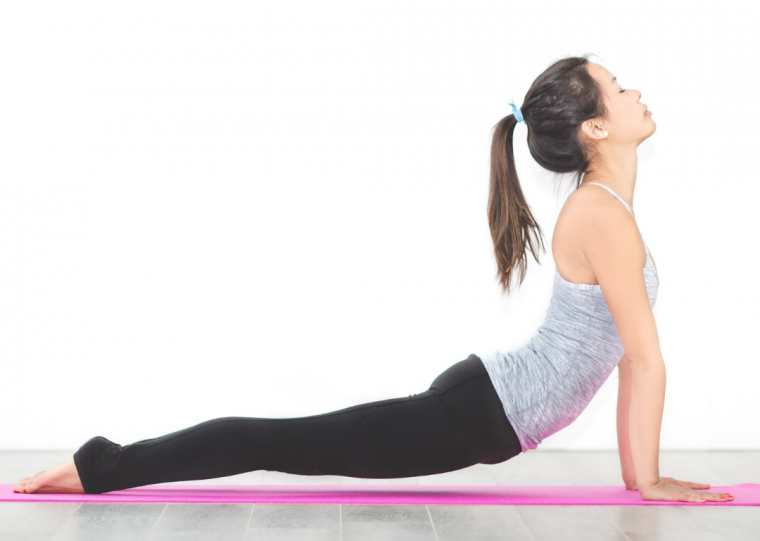 Mobility and flexibility can go hand in hand but they are not the same thing. Mobility is about the ability of our bones and joints to be able to move, different from our muscles’ ability to stretch. For more about the difference between mobility and flexibility and why both are important for our daily lives, check out our flexibility v. mobility blog.
Mobility and flexibility can go hand in hand but they are not the same thing. Mobility is about the ability of our bones and joints to be able to move, different from our muscles’ ability to stretch. For more about the difference between mobility and flexibility and why both are important for our daily lives, check out our flexibility v. mobility blog.
Mobility is the third part of our balanced body that is so important for injury prevention. Plenty of injuries are caused due to bones getting stuck. Spinal mobility is a great example. If your spine can’t bend or twist with an adequate range of motion, you may develop vertebra damage, back pain, hip problems, or knee or ankle injuries. It can also just plain make it difficult to do everyday tasks. We had a client who once had clicking and pain in her shoulder. It was caused by a non-moving scapula or shoulder blade. Every time she put her hand or elbow up her shoulder would click because the arm was popping out of socket. Shoulder blade mobility exercises fixed the problem.
Too much mobility can also cause injury. Often people who have extremely mobile joints (unless they are pregnant) have some level of hypermobility or double-jointedness, a genetic condition that causes lose ligaments. The ligaments in your body are supposed to help hold your bones in place. When these ligaments are loose, the joints are more mobile. This can cause legs, arms, knees, etc., to pop out of socket or out of place with no real effort at any given moment. Hypermobility can also cause people to roll their ankles at the drop of the hat. These people are more likely to have SI (sacroiliac) joint problems because their ligaments allow for easy movement of this hip joint. Ever heard someone say “don’t lock your knees” when standing for long periods? Well, locking your knees is something hypermobile people do because a lot of them can actually get their knees to bend backwards. This can cut off blood flow and can make people pass out when standing for a long period of time with “locked knees.” Just as with strength and flexibility, being mobile is important, but it is also important to have the strength to be able to control your mobility.
Alignment:
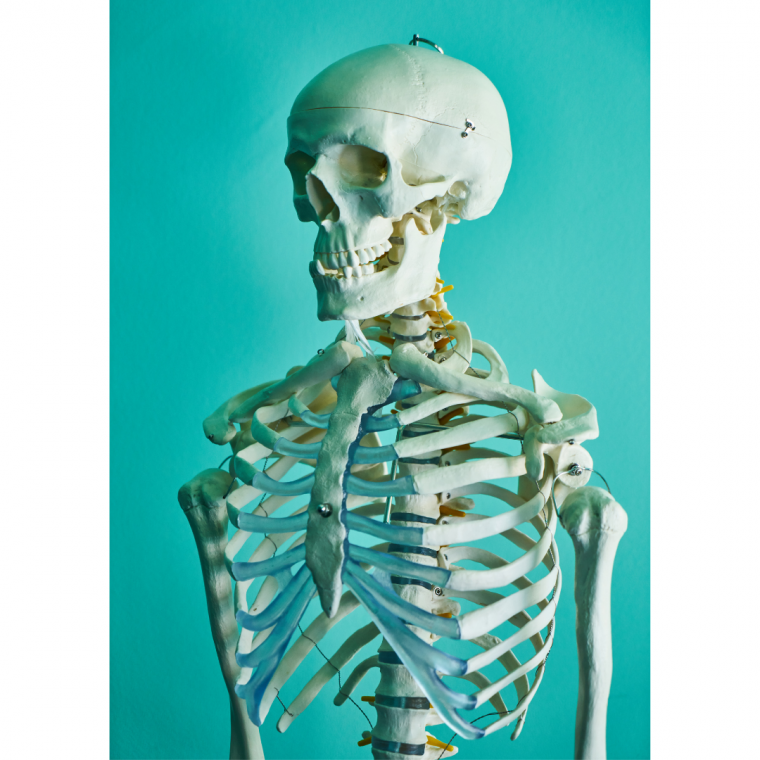 Alignment is the final part of building body balance. If you always stand with your weight on one leg, that’s an alignment problem. It can lead to injury because of over use and tightness of one leg or weakness on the other. Standing with your back arched or your shoulders hunched all the time is, again, an alignment problem, and again, causes imbalances. Improving your alignment helps decrease your risk of injury by creating better strength balance and helping improve both flexibility and mobility. To learn more about what alignment is and how you can improve it, check out our alignment blog.
Alignment is the final part of building body balance. If you always stand with your weight on one leg, that’s an alignment problem. It can lead to injury because of over use and tightness of one leg or weakness on the other. Standing with your back arched or your shoulders hunched all the time is, again, an alignment problem, and again, causes imbalances. Improving your alignment helps decrease your risk of injury by creating better strength balance and helping improve both flexibility and mobility. To learn more about what alignment is and how you can improve it, check out our alignment blog.
Building body balance is like having an efficiently run factory or office. If everything is running well and every one is able to do their job to their best ability, yet not be over worked by doing multiple people’s jobs but not avoiding work and doing nothing, then everything goes smoothly. Productivity goes up, deadlines are met, and people are happy. Your body is the same way. It suffers less pain, works and moves better, and is happier when all the parts are working together to their best ability. Body balance may be the most important aspect of injury prevention, but is not the only aspect. There are also nutrition, body awareness and balance (the ability to stand on one foot kind).
Balance (the not falling over kind):
 As we age, our ability to balance is likely to deteriorate. Our balance ability actually starts to deteriorate at age 30. This can lead to falls and subsequent injuries because people lose their balance. Working to improve balance itself can help decrease our risk of injury as we get older. However, improving balance often requires working on strength, flexibility and mobility and creating a balanced body. For more information on balance, how it works and how you can improve it, check out our balance blog.
As we age, our ability to balance is likely to deteriorate. Our balance ability actually starts to deteriorate at age 30. This can lead to falls and subsequent injuries because people lose their balance. Working to improve balance itself can help decrease our risk of injury as we get older. However, improving balance often requires working on strength, flexibility and mobility and creating a balanced body. For more information on balance, how it works and how you can improve it, check out our balance blog.
Body Awareness:
As you might have guessed by everything above, body awareness does play a part in injury prevention. If we don’t know what our body is doing or how it is moving, how can we change it? How can we mobilize our shoulder blades if we can’t feel them moving? How can we prevent grinding in our hips if we can’t feel the separation and isolation of our leg bone from our hip bones? How can we engage our hamstrings instead of our quads if we can’t learn how to relax overused quads? The answer is, we can’t. You have to be able to feel your body to control it, or to visualize how to move optimally. That comes down to body awareness. The more aware you are of your body, the more control you have. The more control you have, the more it does what you ask or the more likely you are to be able to figure out why it isn’t doing what you ask. In addition, the more body awareness you have, the more likely you are to notice pain or tightness before that pain or tightness becomes an actual injury. Body awareness is extremely important for injury prevention and injury recovery. However, it is always easier to listen to your body when stress is not drowning out your ability to listen.
Stress Relief and Release:
 Stress can, and often does, cause tension in our bodies. Tension can cause muscles to lock up and either over work or get tighter. And, as seen above, those things can cause injuries and body imbalances. Stress can come from outside influences; it can also come from the pressure we put on ourselves during our workout sessions. If we are trying to meet unrealistic goals or compare ourselves to others whose bodies or strength levels might be different than ours, then we can create a pressure that causes us to try too hard, push through pain, or not listen properly to what our body is telling us. Overall, exercising creates endorphins which do help relieve stress. However, it is up to us, and how instructors treat us, as to how much relaxation benefit we get out of exercising.
Stress can, and often does, cause tension in our bodies. Tension can cause muscles to lock up and either over work or get tighter. And, as seen above, those things can cause injuries and body imbalances. Stress can come from outside influences; it can also come from the pressure we put on ourselves during our workout sessions. If we are trying to meet unrealistic goals or compare ourselves to others whose bodies or strength levels might be different than ours, then we can create a pressure that causes us to try too hard, push through pain, or not listen properly to what our body is telling us. Overall, exercising creates endorphins which do help relieve stress. However, it is up to us, and how instructors treat us, as to how much relaxation benefit we get out of exercising.
Nutrition:
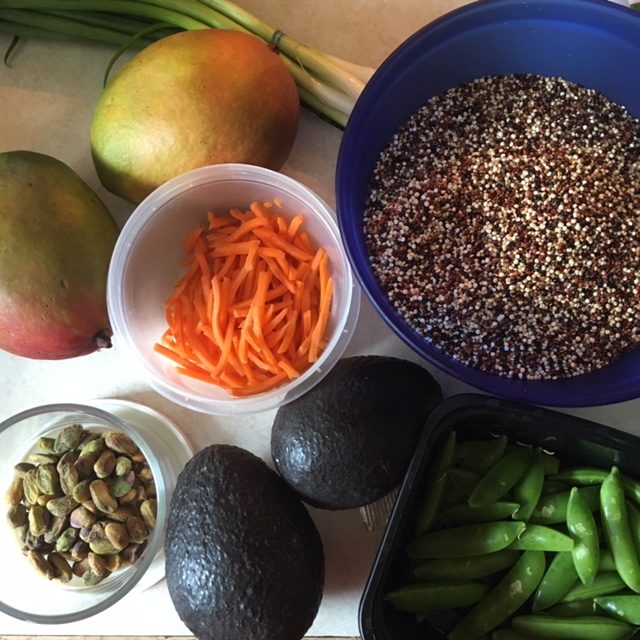 The last aspect of injury prevention is eating healthy. Adequate nutrition gives the body the support it needs to thrive. Macronutrients, like proteins, fats and carbohydrates, as well as micronutrients, like vitamins and minerals, are some of the supplies that cells, organs and systems must have to do their respective jobs within the body. Much like going to sleep each night gives our bodies an opportunity to recharge for the next day, a diet rich in a variety of nutrients encourages ongoing maintenance, creation and repair from small cells to large organs. Even for those who have formally studied nutrition, the information available can be overwhelming, inconsistent and confusing. To improve your personal nutrition to prevent injury and help your body perform to the best of its ability, follow the guidelines of eating mostly fresh or whole foods (versus packaged), eat a wide variety of those foods and stop when you’re 80% full.
The last aspect of injury prevention is eating healthy. Adequate nutrition gives the body the support it needs to thrive. Macronutrients, like proteins, fats and carbohydrates, as well as micronutrients, like vitamins and minerals, are some of the supplies that cells, organs and systems must have to do their respective jobs within the body. Much like going to sleep each night gives our bodies an opportunity to recharge for the next day, a diet rich in a variety of nutrients encourages ongoing maintenance, creation and repair from small cells to large organs. Even for those who have formally studied nutrition, the information available can be overwhelming, inconsistent and confusing. To improve your personal nutrition to prevent injury and help your body perform to the best of its ability, follow the guidelines of eating mostly fresh or whole foods (versus packaged), eat a wide variety of those foods and stop when you’re 80% full.
Being overweight, sometimes a byproduct of inadequate nutrition, increases your chances of injuries quite a bit. It puts added pressure on your joints and can cause joint damage. In addition, a lack of certain nutritional elements can increase your risk of various injuries. To learn more about nutrition and how it can affect every aspect of your life, including injuries, check out our nutrition blog.
What We at Urban Fitness Do:
We at Urban Fitness understand the importance of injury prevention for every one of our clients. We work to incorporate all the different elements above in our clients’ workouts, with individualized focus on what that client most needs to create more balance in their bodies and lives. We provide a calm and encouraging atmosphere, with positive, patient, and enthusiastic instruction. We tailor each workout to that individual client’s needs that day, week, month, and year, and are aware that those needs are always changing. We don’t just give a workout, we teach the workout. We help explain how to do exercises, instead of just what to do, to help build better and more even muscle strength. We give personalized corrections and notes to help build better body awareness. We answer any and all questions our clients have about what should be working, how it should be working, and why it matters. We include flexibility and mobility exercises in our strength training workouts. We offer help with nutrition and healthy eating habits. We encourage our clients to make progress by doing their homework but also are also understanding and try not to add pressure or stress. We are honest with our clients as to why we are asking them to do something or what we think would help improve their injury prevention program. We also work with physical therapists, chiropractors and other instructors to help improve our knowledge about injuries and injury prevention and how best to help our clients prevent injury, as well as heal them when they occur. We also encourage our clients to work with massage therapists, physical therapists, doctors, acupuncturists, and chiropractors, to help with potential injury risks that we find in our sessions. Finally, we provide whatever education or resources we can, to help our clients best understand fitness, nutrition, and injury prevention issues.
Of course, injury prevention only goes so far. No matter how injury-prevention focused you are, accidents and injuries do happen. However, the more you can incorporate the above injury prevention principals, the better chance you have for a faster recovery and the more likely the injury won’t be as severe. When injuries do happen, even mild ones, proper injury recovery is important to help prevent against more and worse injuries down the road. Learn more about injury recovery on our injury recovery blog (coming very soon)!
Looking to add more injury prevention into your personal training program? Schedule your free 90 minute consultation.

This blog was contributed by our Pilates guru, Kaethe Birkner. Kaethe is a certified Pilates instructor through Balanced Body and dances ballet professionally at Continental Ballet Company. She has been teaching Pilates since 2012 and has been taking Pilates since 2004.

Addie Kelzer is a certified personal trainer and nutrition consultant. She believes that by making fitness and good food practical, her clients will hold the power to positively change their health and the health of those closest to them.
